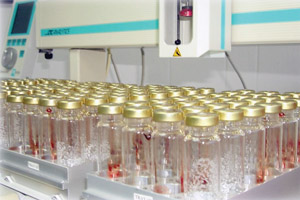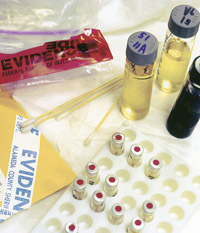 Toxicology is a wide and diverse subject, covering the toxic effects of chemicals on living organisms. In this article, we will be concerned with the effects of chemicals on humans, especially in relation to serious crimes.
Toxicology is a wide and diverse subject, covering the toxic effects of chemicals on living organisms. In this article, we will be concerned with the effects of chemicals on humans, especially in relation to serious crimes.
 The German chemist Paracelsus is widely credited with being the ‘father’ of modern toxicology. It was he who coined the famous maxim “The dose makes the poison”, although earlier texts are known. Thus, paracetamol is safe when the recommended dose is taken to relieve pain, but very dangerous in overdose.
The German chemist Paracelsus is widely credited with being the ‘father’ of modern toxicology. It was he who coined the famous maxim “The dose makes the poison”, although earlier texts are known. Thus, paracetamol is safe when the recommended dose is taken to relieve pain, but very dangerous in overdose.To be more specific, forensic toxicology concerns itself with the effects of chemicals, drugs and poisons on humans, especially where those compounds are administered with malicious intent, ie in medico-legal matters. For that purpose samples will be taken from the victim (blood, urine, hair, oral fluids etc) and analysed for the presence of any drugs present. Also important is determining the amount of drug present; in other words the forensic toxicologist has to know what therapeutic drug levels are when an individual is taking a particular drug as prescribed by their doctor. The presence of levels above therapeutic are indicative of an overdose of the drug.
Of course, it is up to the police (and other parties) to determine how the overdose was administered, ie accidentally or deliberately, and by whom if homicide is suspected.
It should be mentioned that the study of forensic toxicology is not new. Throughout the ages doctors have been expected to be familiar with the signs and symptoms of common poisons on the human body, and bioassays in the form of food tasters have been employed by monarchs down the centuries.
However, the first reliable analytical test for poison was developed by Marsh in 1836. Marsh’s test, as it became known, detected arsenic in human body fluids and, it is said, led many a woman to the gallows – arsenic poisoning being a favourite method of disposing of inconvenient husbands etc among the ladies.
Additional tests for other poisons were developed during the Victorian Era, based on the extraction of tissues and chemical analysis of any residues. It can be imagined that this procedure was lengthy and time consuming.
Modern analytical technology such as gas chromatography or liquid chromatography mass spectrometry (GCMS or LCMS) has considerably enhanced the toxicologist’s ability to detect increasingly smaller amounts of drugs and poisons in biological fluids. The basic principle is that a sample or an extract of a sample is passed through a column of special material under controlled conditions. That separates the basic components of the sample (if there are any), such as the active compound and any breakdown product or metabolite.
 The type of column depends on the nature of the drug(s) being looked for, ie are they basic, acidic or neutral. Once the chromatographic process is finished, compounds of interest are further analysed by mass spectrometry, a procedure in which each individual compound is further fractionated into a pattern specific to that compound, and then the amount present is measured. As can be imagined, there is a lot of computer hardware and software involved.
The type of column depends on the nature of the drug(s) being looked for, ie are they basic, acidic or neutral. Once the chromatographic process is finished, compounds of interest are further analysed by mass spectrometry, a procedure in which each individual compound is further fractionated into a pattern specific to that compound, and then the amount present is measured. As can be imagined, there is a lot of computer hardware and software involved.Ready-made systems are now available which can automate the whole process, thus allowing for mass and rapid screening of samples from the victims of major disasters such as a plane crash or bus crash or motorway pile up. These do not come cheap, however; a cool £250,000 is the going price for one such machine. Of course, being such complex systems, they do require constant maintenance and adequate support from the company that made the system.
These systems are rapidly superseding older analytical techniques such as paper chromatography, thin layer chromatography and ultra violet and infrared spectroscopy, and have the advantage of being able to process large numbers of samples automatically. Sophisticated computer programmes then analyse the raw data and produce the results in an easily readable (and intelligible) format. It is then up to the toxicologist to interpret the results in the light of whatever additional information has been given to them, and present them to the relevant authorities.
So what do you need to become a forensic toxicologist? The prime qualities are impartiality, an enquiring mind and good analytical skills – plus an interest in the subject itself. Many universities now run courses in forensic science, which may include a module on forensic toxicology. There are no specific qualifications, but a degree in chemistry, biochemistry or biological science is a good starting point.
Further training can be given ‘on the job’, while several learned bodies such as the Royal College of Pathologists, the British Toxicology Society and the American Board of Toxicology provide a variety of postgraduate qualifications.


